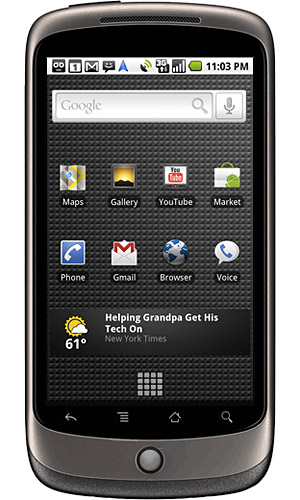Google’s Nexus One Discontinued. Wherefore Art Thou, Open Android?
So today the last shipment of Nexus One devices were delivered to Google. Once the inventory runs out, that’s all she wrote for the now-famous direct-buy, no-carrier phone. For its time, the phone’s specs were some of the best ever seen, and really still have not been far eclipsed in the seven months since its online-only release.
The beauty of the Nexus One was in its flexibility and the ease in which it could be hacked to its owner’s content. The open bootrom, in layman’s terms, meant that should you find the stock OS insufficient, a couple lines on a command prompt later you could potentially load any number of user-designed OS’s based on Google’s AOSP (Android Open Source Project). One of the more famous ones now is CyanogenMOD, which is a group project to bring many custom improvements, both visual and performance-wise, to the platform.
The business model was not without its detractors, however. To purchase the phone was to buy it outright (except through T-Mobile): it came unlocked for any carrier, you just chose the radio inside the phone (for T-Mobile/WIND or AT&T/Rogers/Bell/Telus). For $529, this was not the cheapest option, but the fact that there was no contract that needed to be signed. In a sense, the phone, once purchased, was about as free and open as you could possibly imagine.
But the experiment didn’t work: Apple sold millions of iPhones in the time that Google sold only 135,000 Nexus One devices. Perhaps people in the United States just weren’t comfortable buying a phone outright; their allegiances to the subsidized carrier prices were too strong. And what’s a two-year contract in the long run? For me, it’s two years too long.
So now what? What happens to open Android? Where does one go to get his hackable Froyo? For all we’ve heard about Motorola making it practically impossible to hack its new Droid X phone, the move seems to be away from the open concept of Android and into the OEM-controlled UI changes and awful pre-loaded junkware of AT&T and Verizon. When we purchase a phone, we should have the right to remove programs we don’t want and don’t need. But the carriers feel that with their subsidies they have the right to lock down the devices we buy. It’s ludicrous.
So the Nexus One may go down as a failure in Google’s pocketbooks. But the community that has derived from its open nature is far more important. Thousands of people band together on forums like XDA-Developers to try and crack the problems that Google couldn’t. No 720p video recording? No problem. Battery life getting you down? Install a custom Linux kernel. It’s all possible with the Nexus One, and my fear is that in the future Google will be too scared to pursue the same results with a different phone.
The Nexus One will still be sold via Vodafone in Europe, KT in South Korea, and perhaps some other vendors. But when the inventory runs out on Google.com/phone, it will be the end of an era. I don’t think we have to worry about the success of Android as a platform: the Droid X and Droid Incredible are still out-selling most other smartphones in the US, and Android was the only platform to gain users in the Feb-May time period. But for open Android, it’s a different story.
(via ReadWriteWeb)
| Print article | This entry was posted by GuruDaniel on July 19, 2024 at 11:40 am, and is filed under Editorials, Google Android. Follow any responses to this post through RSS 2.0. You can leave a response or trackback from your own site. |







Comments are closed.